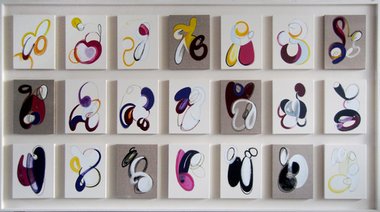John Hurrell – 3 August, 2010
Matthew Browne's painted lines and shapes here appear to allude to the physiognomies of personalities such as Mickey, Elmer, Pluto, Bugs and Goofy under Browne's abstract forms - with their buckling, stretched ovals and twisting squashed, pneumatic boomerangs. There is a large framed tray holding 21 small canvases - five of them brown linen and all carefully positioned for maximum ‘musical' effect.
This collection of paintings and sculpture by Matthew Browne includes intriguing works that seem to relate to animators’ drawings for cartoon films or comics. The lines have a fluidity reminiscent of cursive script with its diagonally aligned loops, and the drawings artists like Ub Iwerks, Walt Disney and Chuck Jones did for the talking heads and flexible moving bodies of animal characters.
In this country Mark Braunias and Robert McLeod have explored aspects of this terrain, as has the late Elizabeth Murray overseas. Matthew Browne’s painted lines and shapes here appear to allude to the physiognomies of personalities such as Mickey, Elmer, Pluto, Bugs and Goofy under Browne’s abstract forms - with their buckling, stretched ovals and twisting squashed, pneumatic boomerangs. There is a large framed tray holding 21 small canvases - five of them brown linen and all carefully positioned for maximum ‘musical’ effect.
These forms could be heads, feet, facial details like black glistening noses or ogling eyes, or sweeping arm and leg movements - all alluded to with pencil, vinyl tempera, and oilstick. The work Pages From a Life, has a dynamic complexity that the simpler, much larger single canvas paintings lack, a movement of surging arabesques and drooping forms. It is the best thing in the room, but some of the others include smeary Baconesque flourishes with kidney shapes, and tremulously quivering parallel contours that seem to be ‘movement lines’.
Browne’s sculptures are quite different. They present taut Gabolike tarlatan forms on curved outlines of copper tubing, inflected, bent sail shapes that seem to change in volume as you walk past. They are too small to seem to be other than preparatory maquettes, and lack the ‘sensitive’ pentimenti drawn (or erased) with paint onto the canvases. They have a baffling plodding clumsiness that contradicts the wiggling but entertaining nuances of the canvas ‘pages.’
The show comes with a small pamphlet containing an illustrated mini-essay by Ed Hanfling, discussing Clement Greenberg. I think because Browne is not interested in the modernist picture plane surface, he doesn’t really pertain to Greenberg’s theories, for he draws into the space, not onto it. However it’s nice that Hanfling is prodding the discussion along, even if it is somewhat antiquated.
John Hurrell



 Advertising in this column
Advertising in this column Two Rooms presents a program of residencies and projects
Two Rooms presents a program of residencies and projects



This Discussion has 0 comments.
Comment
Participate
Register to Participate.
Sign in
Sign in to an existing account.